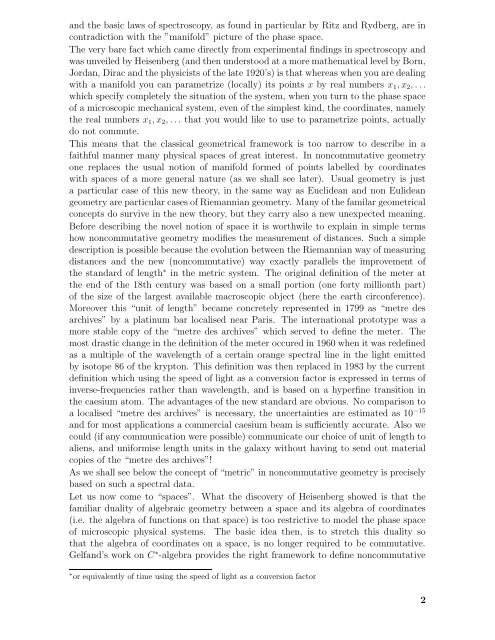Alain Connes (pdf)
Alain Connes (pdf)
Alain Connes (pdf)
Create successful ePaper yourself
Turn your PDF publications into a flip-book with our unique Google optimized e-Paper software.
and the basic laws of spectroscopy, as found in particular by Ritz and Rydberg, are in<br />
contradiction with the ”manifold” picture of the phase space.<br />
The very bare fact which came directly from experimental findings in spectroscopy and<br />
was unveiled by Heisenberg (and then understood at a more mathematical level by Born,<br />
Jordan, Dirac and the physicists of the late 1920’s) is that whereas when you are dealing<br />
with a manifold you can parametrize (locally) its points x by real numbers x 1 , x 2 , . . .<br />
which specify completely the situation of the system, when you turn to the phase space<br />
of a microscopic mechanical system, even of the simplest kind, the coordinates, namely<br />
the real numbers x 1 , x 2 , . . . that you would like to use to parametrize points, actually<br />
do not commute.<br />
This means that the classical geometrical framework is too narrow to describe in a<br />
faithful manner many physical spaces of great interest. In noncommutative geometry<br />
one replaces the usual notion of manifold formed of points labelled by coordinates<br />
with spaces of a more general nature (as we shall see later). Usual geometry is just<br />
a particular case of this new theory, in the same way as Euclidean and non Eulidean<br />
geometry are particular cases of Riemannian geometry. Many of the familar geometrical<br />
concepts do survive in the new theory, but they carry also a new unexpected meaning.<br />
Before describing the novel notion of space it is worthwile to explain in simple terms<br />
how noncommutative geometry modifies the measurement of distances. Such a simple<br />
description is possible because the evolution between the Riemannian way of measuring<br />
distances and the new (noncommutative) way exactly parallels the improvement of<br />
the standard of length ∗ in the metric system. The original definition of the meter at<br />
the end of the 18th century was based on a small portion (one forty millionth part)<br />
of the size of the largest available macroscopic object (here the earth circonference).<br />
Moreover this “unit of length” became concretely represented in 1799 as “metre des<br />
archives” by a platinum bar localised near Paris. The international prototype was a<br />
more stable copy of the “metre des archives” which served to define the meter. The<br />
most drastic change in the definition of the meter occured in 1960 when it was redefined<br />
as a multiple of the wavelength of a certain orange spectral line in the light emitted<br />
by isotope 86 of the krypton. This definition was then replaced in 1983 by the current<br />
definition which using the speed of light as a conversion factor is expressed in terms of<br />
inverse-frequencies rather than wavelength, and is based on a hyperfine transition in<br />
the caesium atom. The advantages of the new standard are obvious. No comparison to<br />
a localised “metre des archives” is necessary, the uncertainties are estimated as 10 −15<br />
and for most applications a commercial caesium beam is sufficiently accurate. Also we<br />
could (if any communication were possible) communicate our choice of unit of length to<br />
aliens, and uniformise length units in the galaxy without having to send out material<br />
copies of the “metre des archives”!<br />
As we shall see below the concept of “metric” in noncommutative geometry is precisely<br />
based on such a spectral data.<br />
Let us now come to “spaces”. What the discovery of Heisenberg showed is that the<br />
familiar duality of algebraic geometry between a space and its algebra of coordinates<br />
(i.e. the algebra of functions on that space) is too restrictive to model the phase space<br />
of microscopic physical systems. The basic idea then, is to stretch this duality so<br />
that the algebra of coordinates on a space, is no longer required to be commutative.<br />
Gelfand’s work on C ∗ -algebra provides the right framework to define noncommutative<br />
∗ or equivalently of time using the speed of light as a conversion factor<br />
2

















